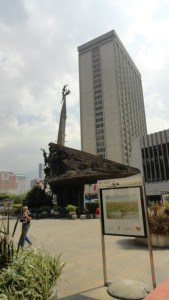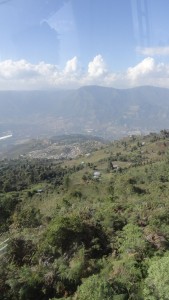I woke up feeling much, much better. I would still have some minor digestive issues over the next few days, and it would take rather a while before I felt completely myself again, but I was able to enjoy our holiday once more. I don’t know whether that’s just the thing that happens with stuff like this, or it was because I started taking antibiotics immediately – either way, back to normal.
It turns out, the timing was rather lucky, because we had been unable to book a walking tour for the 18th. Instead, we had to be content with today, and so, though we had been in Medellin for over 36 hours already, we got our walking tour right when we were ready (I was able) to explore.
We did a tour with Real City Walking Tours, a company that takes you to the actual downtown of Medellin, rather than to just the old buildings. The tour is full of in-depth history of Medellin, Antioquia and Colombia and it takes you around areas that you might find your way to as a tourist and areas that the tour guide believed we would be warned off. The tour is “free” in the sense that you don’t have to pay for it if you don’t want to and the guide makes the tips anonymous. Our guide was Pablo, the owner of the company, and he was excellent. I would highly recommend this as your introduction to downtown Medellin.
Medellin’s story is inspirational, even when we acknowledge the human cost. It’s an incredible story that both allows us to imagine the possibilities of urban renewal and forces us to ask extremely tough questions about what degree of liberty (and, what actual human cost) we’re willing to sacrifice for drastic improvements in qualify of life for the greater population (i.e. what small sacrifices are acceptable for the greater good).
What Medellin has done is that they have built public spaces in formerly bad areas and they have built libraries in barrios. Some examples:
- They took a block that was notorious for drug use and prostitution and put a library and a public square in its place;
- They took old, historically significant buildings nearby that were full of squatters put in the Ministry of Education (education is local in Colombia) and shops and restaurants;
- They put a square in the middle of the downtown full of Botero sculptures;
- And of course, they did a huge library building project and their famous metro (more on that later).
Medellin’s metro-wide crime rate has plummeted and there are signs of growth everywhere. But we need to remember that many, many people died in the transformation and not all of them were killed by the drug gangs and guerrillas.
As Pablo said: if Medellin can do it, think of what your city can do.
After the tour we went out for the local meal, a combination of meats, beans, an egg and a plantain. It’s huge. We ordered one to split and the waitress seemed to think we would starve to death.
After lunch, we too the metro (the only urban rail transit in Colombia) north to one of Medellin’s famous gondolas. Medellin has constructed two gondolas to allow residents to travel safely to work, rather than walking the hundreds (if not thousands) of steps down the mountains, through the barrios, with the threat of muggins or worse. (There are two more gondolas on the way, I believe, as well as a tram that just started running.) I suspect they are extremely inefficient but they are safe and that was the prime concern when the first two were built.
The reason for tourists to go up them is they offer fantastic views both of the city and other the barrios that you might otherwise not want to walk through. The other reason is that the northern one actually takes you to a third gondola that takes you from one of the barrios to the Parque Arvi, a massive public park in the mountains.
Unfortunately we got to Arvi pretty late in the day, there were signs saying we should head back at a certain time and everything appeared to be closing up. So we walked around a bit and Jenn got a coffee, but we didn’t do much. Had I not gotten sick yesterday, I could envision a whole day at Arvi unfortunately it did not work out. But the trip up the gondola and back was worth the cost of admission (whatever it cost, it wasn’t much, less than $2 per person I think).
When we got back, we had some traditional Colombian food at a “wine bar” (the wine was Argentinian) and that was it for the night. By the way: I had soup, Jenn had blood pudding and and a salad and was once again informed it would not be enough food.

